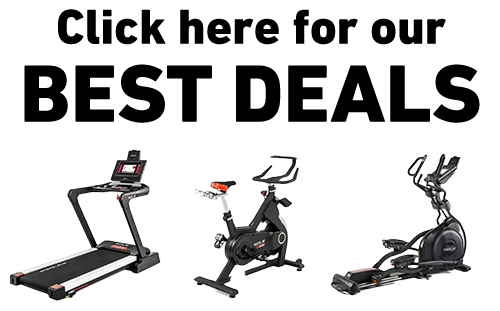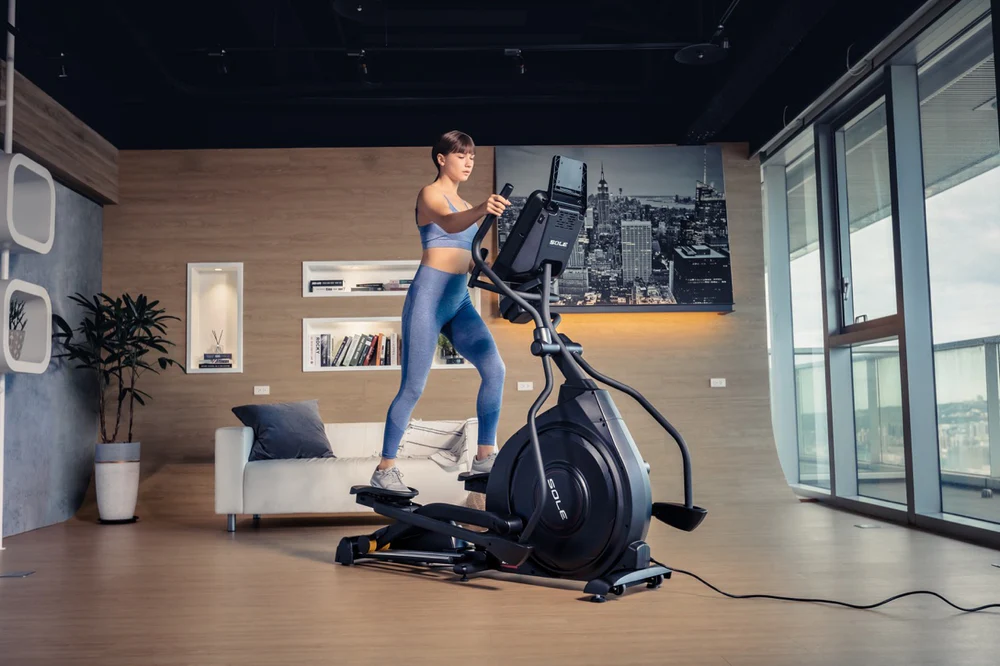Key Takeaways
- Proper form on the elliptical includes maintaining good posture and using your whole foot.
- Adjust settings like resistance and incline to match your fitness level and goals.
- Incorporate interval training and reverse pedaling to maximize your workout.
- SOLE ellipticals offer customizable settings and ergonomic designs for an effective workout.
|
At SOLE Fitness, we’re proud to offer the best treadmills for your home or gym. These machines are crafted to meet the highest standards of quality and performance, ensuring they are ideal for anyone - from fitness novices to seasoned athletes. Featured Products SOLE Ellipticals: Priced from $1,199.99, SOLE ellipticals are known for their ergonomic design, durability, and affordability. They provide a quiet, smooth workout with intuitive consoles, adjustable stride lengths, incline options, and heart rate monitoring, ensuring a comprehensive exercise experience. |
Getting Started
Before you start, ensure you have the right footwear and attire. Sneakers with good arch support and comfortable workout clothes will set you up for success.

Mounting the Elliptical
Mounting the elliptical might seem straightforward, but doing it correctly will set the tone for your workout. Here’s how to do it:
- Stand facing the monitor of the elliptical.
- Hold onto the handlebars for support as you step onto the foot pedals.
- Ensure you have a firm grip and maintain balance.
Most elliptical models will have their step up height - it’s the vertical distance from the ground to the pedals when they are in their neutral position (the position where the pedals are level with each other). For example, our SOLE E25has a step up height of 14” which is considered as normal height.

Once you're on, it's time to adjust the settings to match your fitness level.
Adjusting Settings
Most ellipticals, including SOLE models, come with various settings to customize your workout, and adjusting these correctly will make your exercise more effective and enjoyable. Here’s what to focus on:
- Resistance: Start with a lower resistance and gradually increase as you get more comfortable.
- Incline: Adjust the incline to target different muscle groups; a higher incline focuses more on your glutes and hamstrings.
- Programs: Use pre-set programs that match your fitness goals, whether it's weight loss, endurance, or interval training.
Our ellipticals have different flywheel weights, resistance and incline levels. All our models also come with pre-programmed and user-defined workout routines.
- E25: 20 lbs flywheel weight, 20 resistance levels, 20 incline levels
- E35: 25 lbs flywheel weight, 20 resistance levels, 20 incline levels
- E95: 27 lbs flywheel weight, 20 resistance levels, 20 incline levels
- E95S: 32 lbs flywheel weight, 20 resistance levels, N/A incline levels
- E98: 32 lbs flywheel weight, 40 resistance levels, 20 incline levels
Proper Form and Technique
Maintain Good Posture
Good posture ensures you’re engaging the right muscles and not putting unnecessary strain on your body. Here's what to keep in mind:
- Keep your back straight and shoulders relaxed.
- Engage your core to stabilize your body.
- Look forward, not down, to keep your spine aligned.
Foot Placement
Your foot placement can affect the efficiency of your workout. Make sure to:
- Place your whole foot on the pedal.
- Avoid standing on your toes to prevent calf strain.
- Distribute your weight evenly to reduce joint stress.
Using Swing Arms
Most ellipticals come with movable arms to work your upper body. Using these correctly will provide a full-body workout:
- Hold the handles lightly to avoid gripping too hard.
- Move your arms in sync with your legs for a balanced workout.
- If you want to focus more on your lower body, you can also let go of the handles and place your hands on your hips.
Beginner Workout Tips
Warm-Up Routine
A good warm-up prepares your muscles and gets your heart rate up. Here’s a simple routine:
- Start with 5 minutes of light pedaling with low resistance.
- Gradually increase the resistance for the next 5 minutes.
- Incorporate some dynamic stretches like leg swings and arm circles.
Setting the Right Resistance
The resistance level determines how hard your muscles have to work, and adjusting it properly can help you achieve your fitness goals.
Start with a low resistance level, especially if you're a beginner, to get used to the motion and build your endurance gradually. As you become more comfortable, you can increase the resistance to challenge your muscles and burn more calories.
Here’s a simple guide:
- Begin with a resistance level that feels easy to moderate.
- After 5-10 minutes, gradually increase the resistance by one level.
- Continue to adjust the resistance every few minutes until you find a level that challenges you but still allows you to maintain proper form.
It's better to start slow and build up rather than pushing too hard too soon, which can lead to injury.
Monitoring Heart Rate
Monitoring your heart rate is essential to ensure you're working out at the right intensity. Most ellipticals, including SOLE models, come with built-in heart rate monitors. Here's how to use them effectively:
- Place your hands on the heart rate sensors located on the handlebars.
- Keep a steady grip to get an accurate reading.
- Aim to stay within your target heart rate zone, which is typically 50-85% of your maximum heart rate.

Your maximum heart rate can be roughly calculated by subtracting your age from 220. For example, if you're 30 years old, your maximum heart rate is approximately 190 beats per minute (bpm). Therefore, your target heart rate zone would be between 95-162 bpm.
Workout Variety
Incorporate Interval Training
Interval training involves alternating between periods of high intensity and low intensity, which can help you burn more calories and improve your cardiovascular fitness. Here's a simple interval training routine:
- Warm up with 5 minutes of light pedaling.
- Increase the resistance and pedal at a high intensity for 1 minute.
- Reduce the resistance and pedal at a low intensity for 2 minutes.
- Repeat the high-intensity and low-intensity intervals for 20-30 minutes.
- Cool down with 5 minutes of light pedaling.
Forward and Backward Pedaling
Pedaling backward on the elliptical can target different muscle groups, such as your hamstrings and calves. It also adds variety to your workout and can help improve your coordination. To incorporate backward pedaling:
- Start with a few minutes of forward pedaling to warm up.
- Switch to backward pedaling for 2-3 minutes.
- Alternate between forward and backward pedaling throughout your workout.
Adding Upper Body Exercises
Using the movable arms on the elliptical can provide a full-body workout. To maximize the benefits, try these tips:
- Engage your core and keep your back straight.
- Push and pull the handles in sync with your leg movements.
- Incorporate upper body exercises, such as bicep curls or shoulder presses, by holding light dumbbells while pedaling.

By adding these variations, you can make your elliptical workouts more effective and enjoyable.
Safety and Comfort
Staying Hydrated
Make sure to drink water before, during, and after your exercise session: keep a water bottle within reach while you're on the elliptical, and take small sips regularly to stay hydrated.

Listening to Your Body
Pay attention to how your body feels during your workout. If you experience any pain or discomfort, stop immediately and assess the situation. It's important to differentiate between the normal discomfort of a challenging workout and pain that could indicate an injury. If you're unsure, it's always best to err on the side of caution and consult a healthcare professional.
Sample Workouts
30-Minute Beginner Routine
This routine is perfect for beginners who are just getting started with the elliptical:
- Warm-up: 5 minutes of light pedaling at low resistance.
- Main Workout: 20 minutes of steady-state pedaling at a moderate resistance.
- Cool-down: 5 minutes of light pedaling at low resistance.
This workout helps build your endurance and gets you comfortable with the elliptical.
HIIT Elliptical Workout
High-Intensity Interval Training (HIIT) is great for burning calories and improving cardiovascular fitness. Here’s a sample HIIT workout:
- Warm-up: 5 minutes of light pedaling at low resistance.
- Intervals:
- 1 minute of high-intensity pedaling at high resistance.
- 2 minutes of low-intensity pedaling at low resistance.
- Repeat the intervals for 20 minutes.
- Cool-down: 5 minutes of light pedaling at low resistance.
This workout challenges your body and helps improve your overall fitness level.
Common Mistakes to Avoid
Leaning on the Handlebars
One of the most common mistakes is leaning too heavily on the handlebars, which can reduce the effectiveness of your workout and lead to poor posture.
- Keep a light grip on the handlebars to help maintain balance.
- Engage your core to support your upper body.
- Focus on using your legs to power the movement, not your arms.
Overextending Strides
Another common mistake is overextending your strides - this can put unnecessary strain on your joints and muscles.
- Keep your strides natural and comfortable.
- Avoid stretching your legs too far forward or backward - that’s why knowing your stride length is important.
- Focus on smooth, controlled movements.
SOLE Ellipticals for Beginners
Using an elliptical can be an excellent way to achieve your fitness goals, whether you're looking to lose weight, improve cardiovascular health, or build endurance. By understanding the proper form and techniques, adjusting settings to match your fitness level, and incorporating variety into your workouts, you can make the most out of your elliptical sessions.
SOLE ellipticals are perfect for beginners due to their customizable settings and ergonomic designs. With features like adjustable resistance and incline levels, SOLE ellipticals provide a tailored workout experience that grows with your fitness journey. Investing in a SOLE elliptical ensures you have reliable, high-quality equipment to support your health and fitness goals from the start.
Frequently Asked Questions (FAQ)
What is the best way to start on an elliptical?
Follow these steps to get started:
- Begin with a 5-minute warm-up at a low resistance.
- Gradually increase the resistance as you become more comfortable.
- Focus on maintaining proper form and posture.
- Start with short sessions and gradually increase the duration.
How often should beginners use the elliptical?
Beginners should aim to use the elliptical 3-4 times per week. This frequency allows your body to adapt to the new exercise while providing enough rest to recover and prevent injury.
Can I lose weight using an elliptical?
Yes, you can lose weight using an elliptical. Consistent workouts combined with a healthy diet can help you achieve your weight loss goals. Focus on varying your workouts to include both steady-state and interval training for the best results.
Is it okay to use an elliptical every day?
While it's possible to use an elliptical every day, it's essential to listen to your body and avoid overtraining. Incorporate rest days or alternate with other forms of exercise to give your muscles time to recover.
What are the benefits of reverse pedaling?
Reverse pedaling on an elliptical can provide several benefits:
- Targets different muscle groups, such as hamstrings and calves.
- Improves coordination and balance.
- Adds variety to your workout, preventing boredom and plateaus.





Leave a comment
This site is protected by hCaptcha and the hCaptcha Privacy Policy and Terms of Service apply.